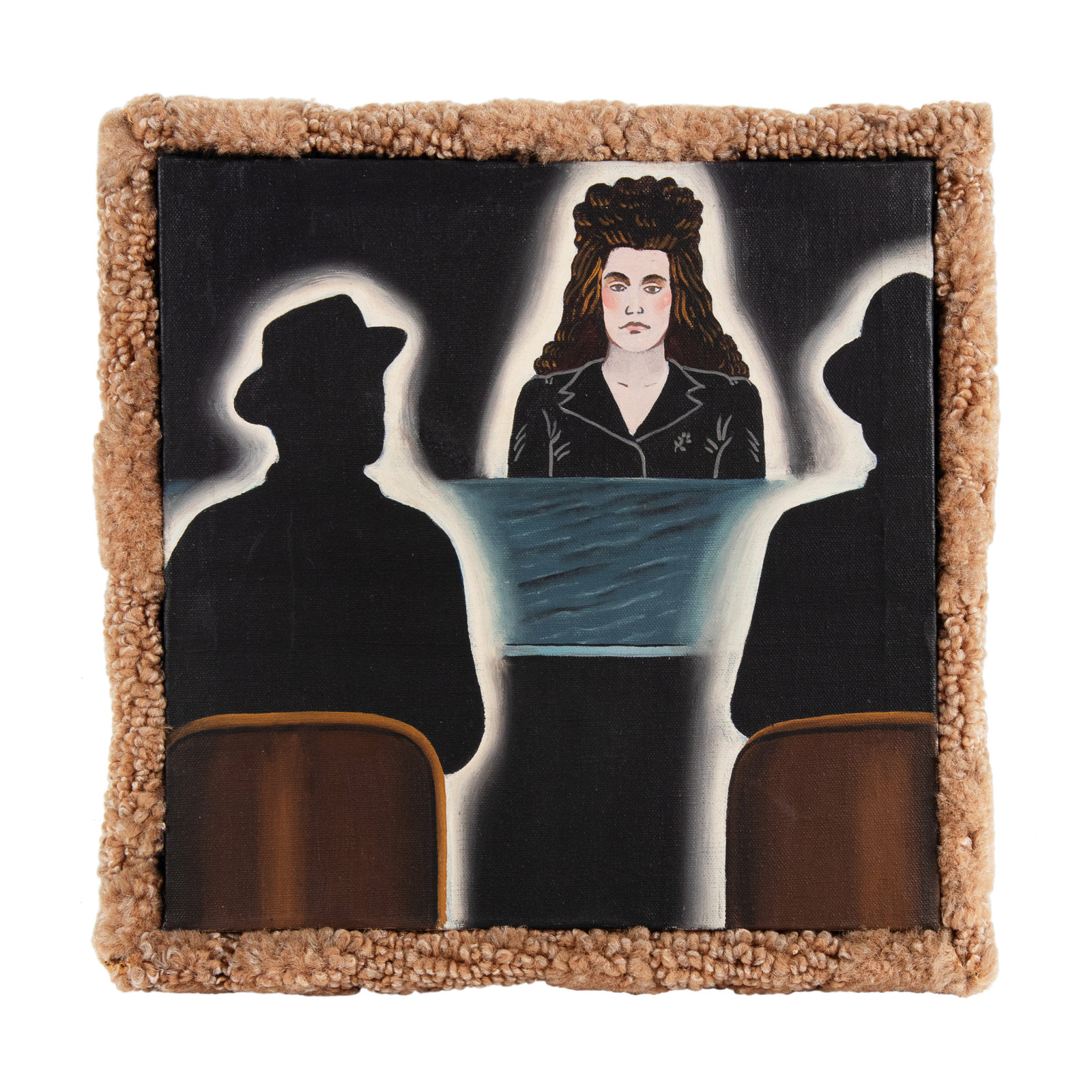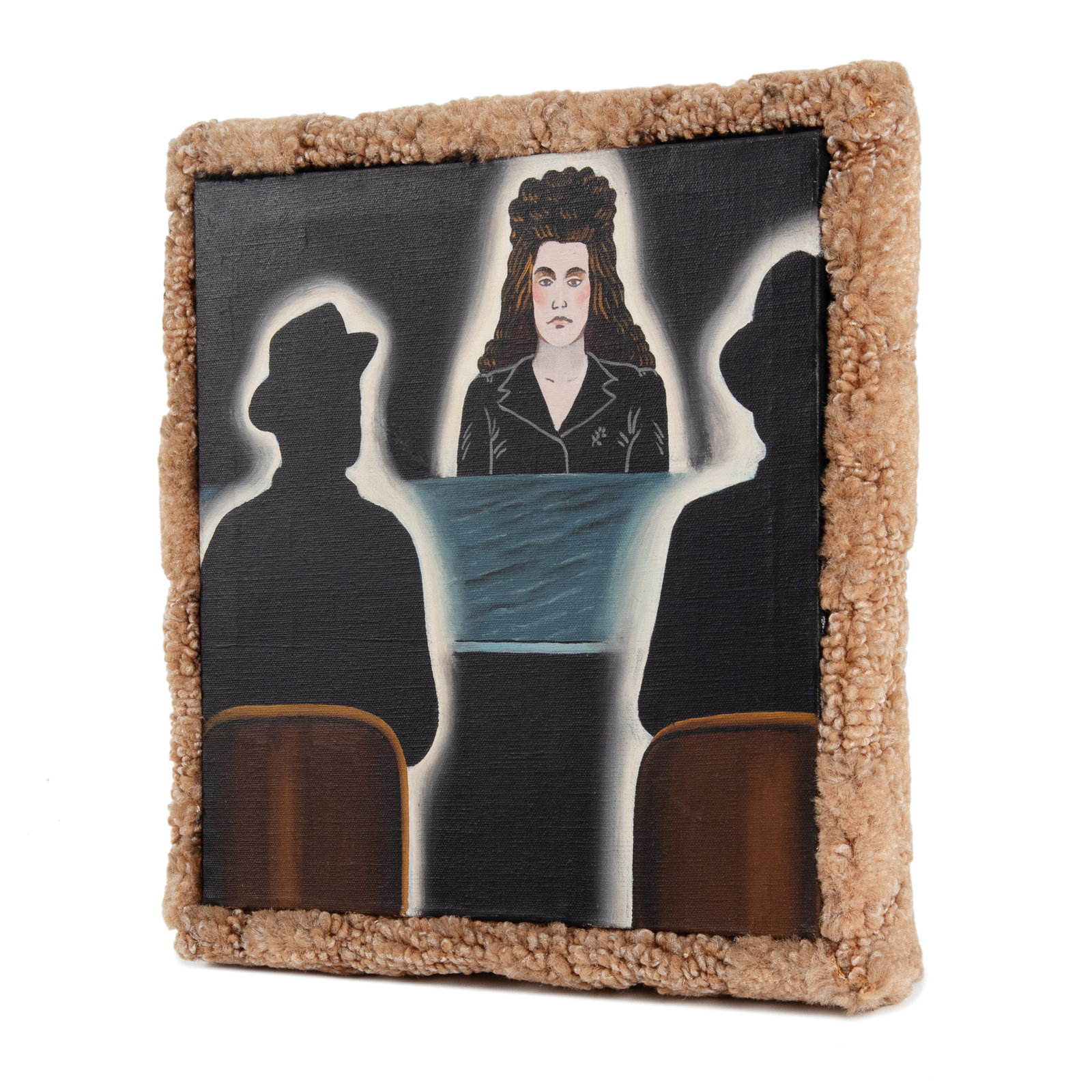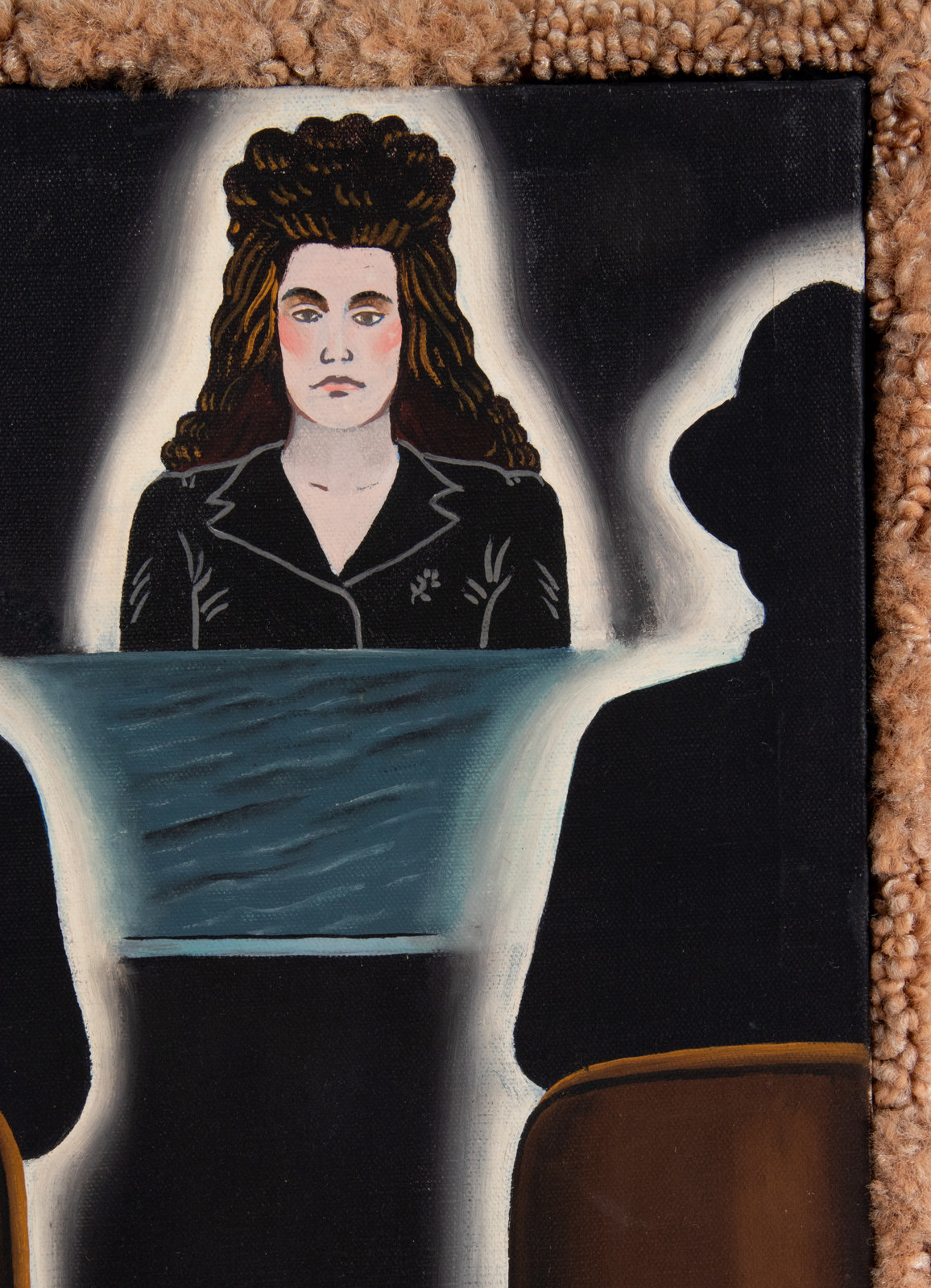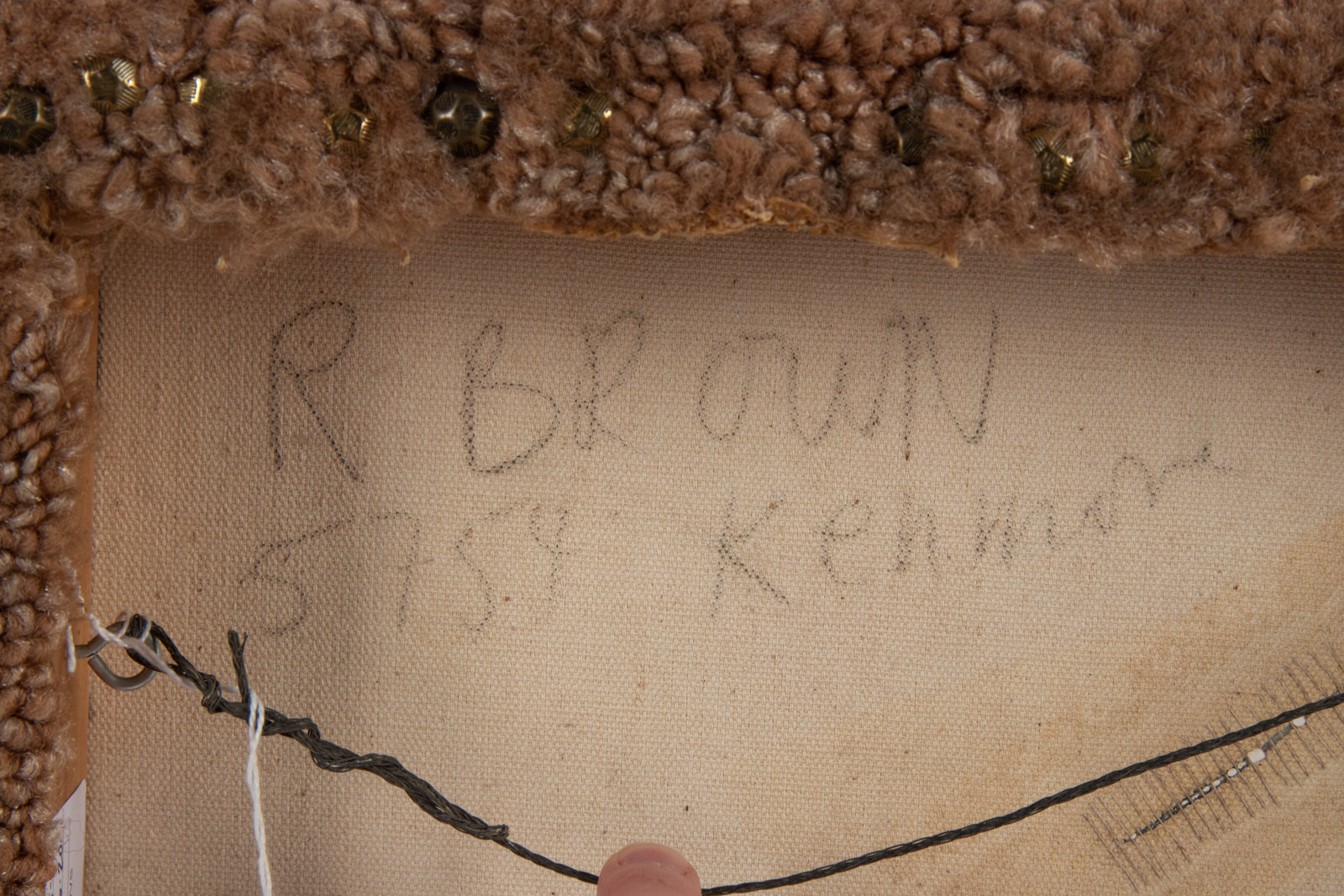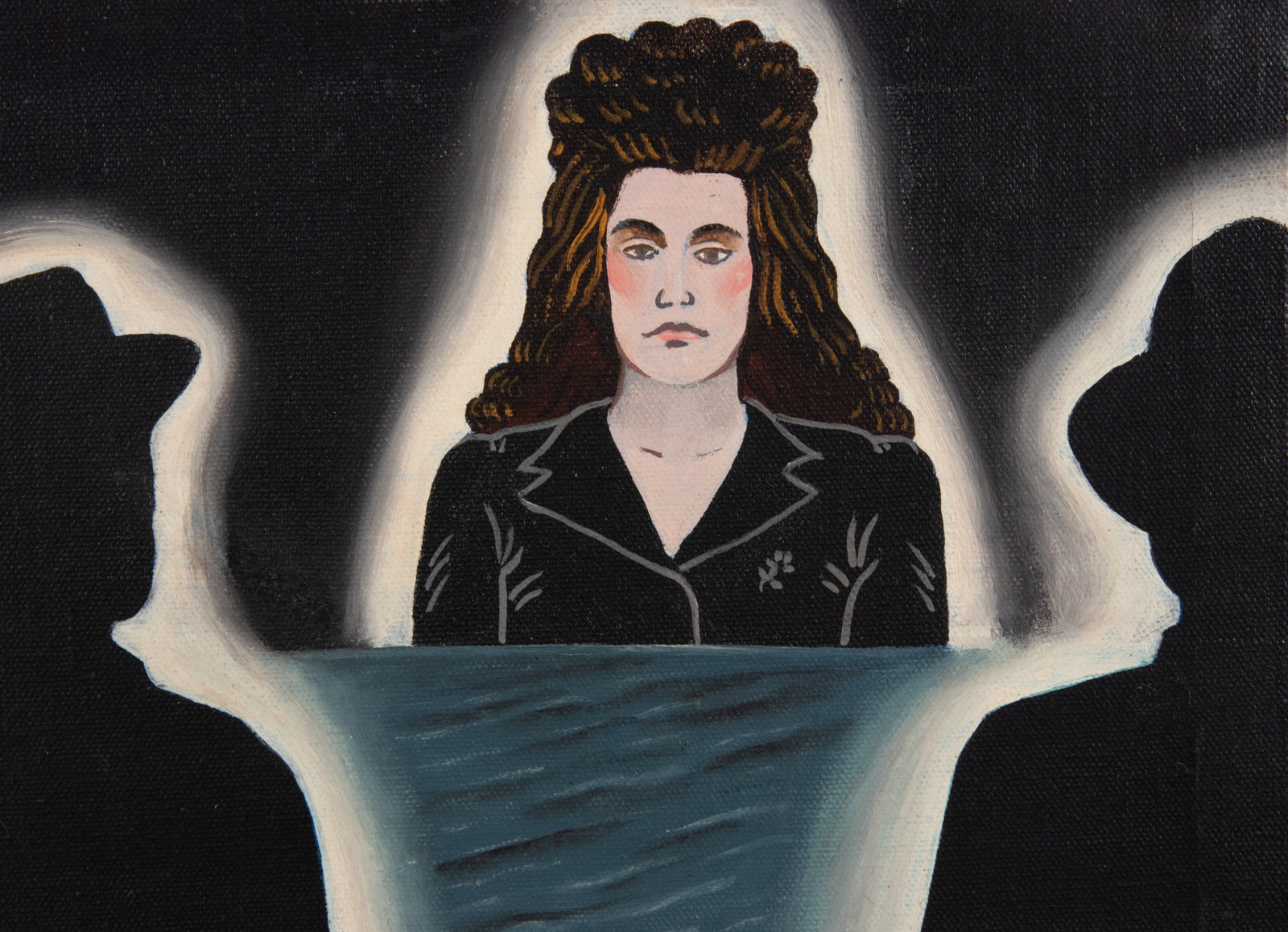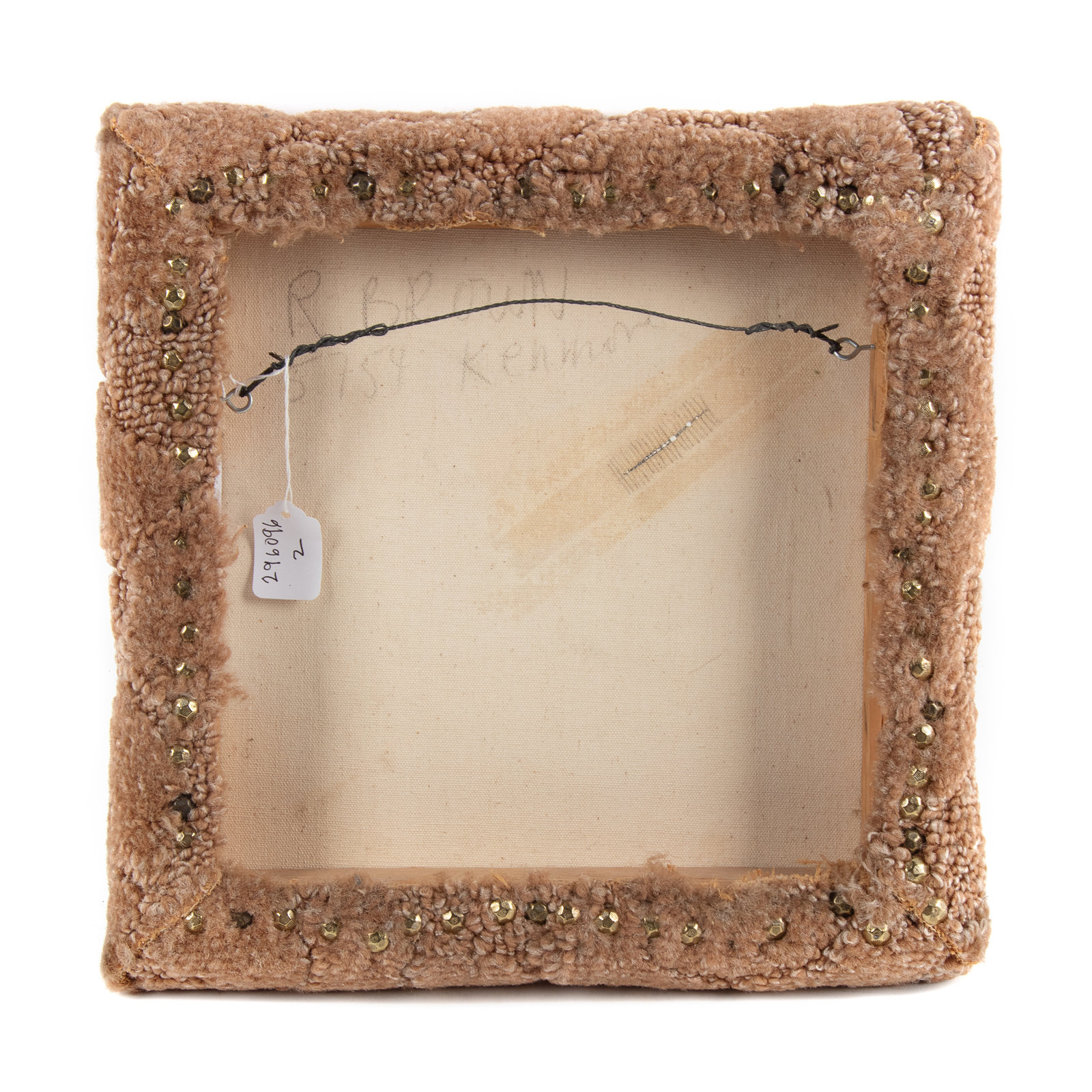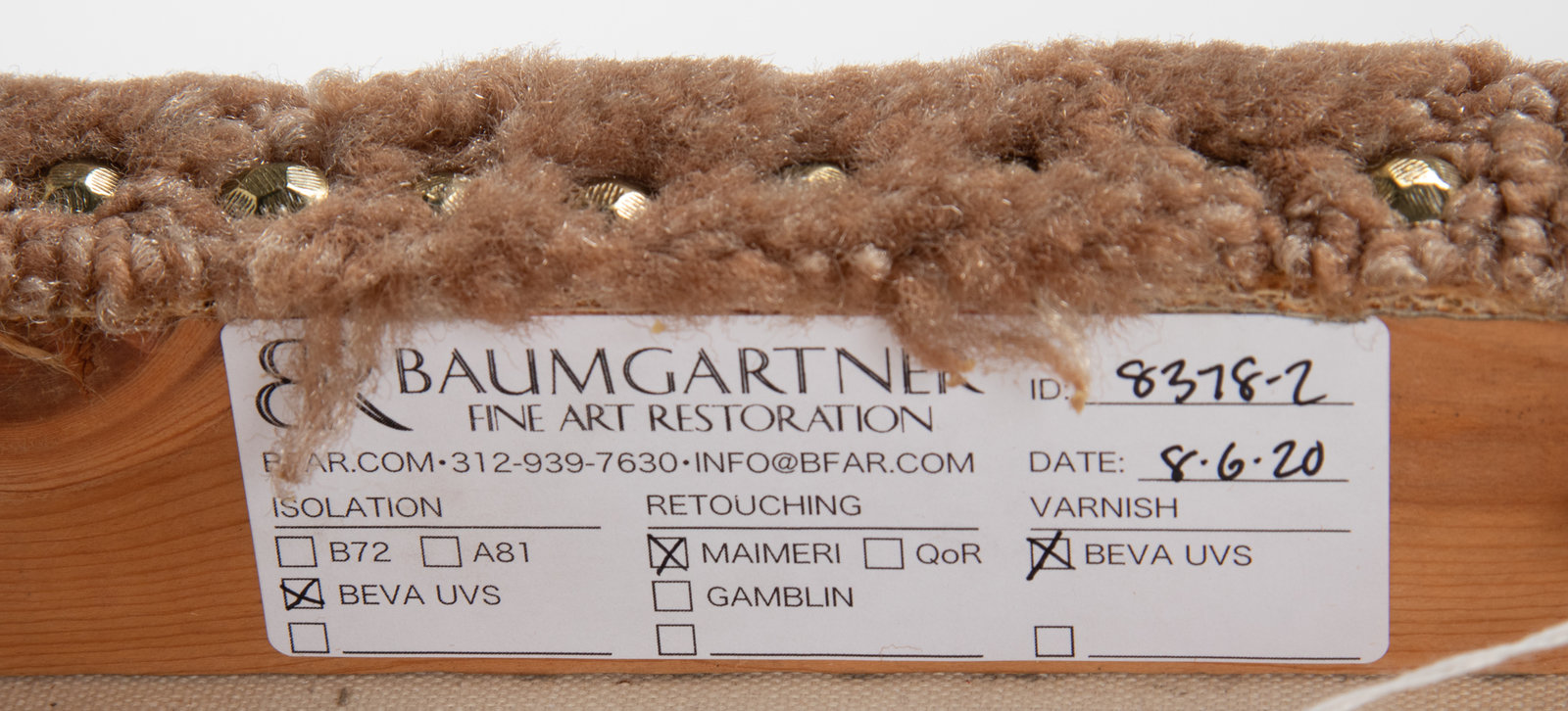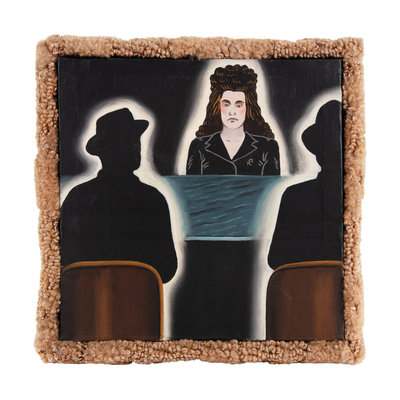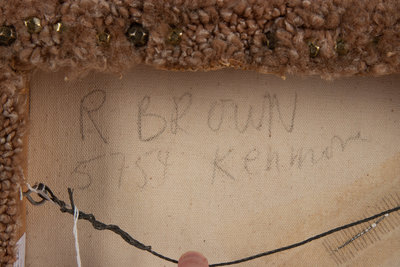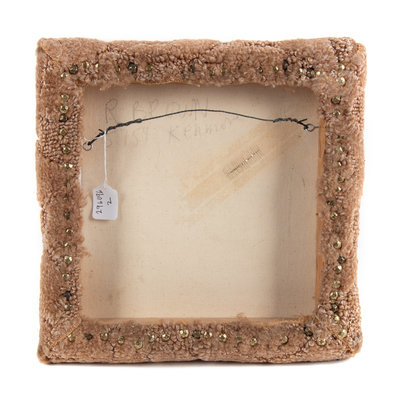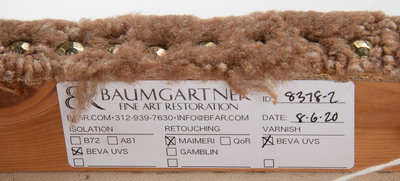Roger Brown
(American, 1941-1997)
Untitled (Two Figures at Bar, Female Behind Counter, Carpet Frame), 1969
Sale 789 - Post War and Contemporary Art
Oct 1, 2020
10:00AM CT
Live / Chicago
Estimate
$30,000 -
$50,000
Sold for $30,000
Sold prices are inclusive of Buyer’s Premium
Lot Description
Roger Brown
(American, 1941-1997)
Untitled (Two Figures at Bar, Female Behind Counter, Carpet Frame), 1969
oil on canvas with pile carpet
signed R. Brown (verso)
14 x 14 inches.
Property from the Collection of Suellen Rocca, Chicago, Illinois
Lot Essays:
Suellen Rocca was an artist as well as instructor, collector in addition to curator. Her distinctive compositional arrangements and initially loose mark-making set her art production apart from her peers, a generation of artists colloquially known as the Chicago Imagists. Likewise, she taught in schools and colleges in and around Chicago for a range of age groups from diverse backgrounds, including students at The School of the Art Institute of Chicago (SAIC), The Jane Addams Hull House, and Elmhurst College, among others. Rocca’s personal collection included the present cache of prized works created by her friends and fellow artists— often obtained through trades and purchases made amongst them— and she stewarded these works just as she dutifully attended to Elmhurst College’s art collection, where she served as Curator and Director of Exhibitions since 2006. Boasting over 150 works, Elmhurst’s collection echoes Rocca’s own, since its growth is, in part, a result of donations and gifts made directly by artists.
Suellen Rocca was an artist as well as instructor, collector in addition to curator. Her distinctive compositional arrangements and initially loose mark-making set her art production apart from her peers, a generation of artists colloquially known as the Chicago Imagists. Likewise, she taught in schools and colleges in and around Chicago for a range of age groups from diverse backgrounds, including students at The School of the Art Institute of Chicago (SAIC), The Jane Addams Hull House, and Elmhurst College, among others. Rocca’s personal collection included the present cache of prized works created by her friends and fellow artists— often obtained through trades and purchases made amongst them— and she stewarded these works just as she dutifully attended to Elmhurst College’s art collection, where she served as Curator and Director of Exhibitions since 2006. Boasting over 150 works, Elmhurst’s collection echoes Rocca’s own, since its growth is, in part, a result of donations and gifts made directly by artists.
Rocca got an incredibly early start in the arts, and followed an esteemed trajectory throughout her career. A bit of a wunderkind, her artistic talents were recognized by a grade school teacher who recommended she attend children’s art classes at The Art Institute of Chicago, and by age 16, she was entering art school on scholarship at SAIC. It was there that instructors nurtured the development of Rocca’s eye, hand and personal collecting habits, and after graduating, she and a group of like-minded friends and fellow SAIC classmates—including Gladys Nilsson— formed an exhibition group.
They named themselves Hairy Who, and in a natural evolution from the informal, generative and also stimulatingly competitive relationships forged in art school, they began mounting now infamous exhibitions at The Hyde Park Art Center on Chicago’s Southside. Together, Rocca and her peers created a bold context for their work, framing it within ornate exhibition designs accompanied by zany ephemera. The control and autonomy their collective, communal efforts yielded was a form of mutual aid—their exhibition group both emphasized and benefited Rocca and each artist as individuals.
The critical acclaim Rocca and the Hairy Who garnered is still unparalleled when considered within the context of Chicago’s history of art. In the greatest form of flattery, they inspired subsequent generations to follow in their footsteps, beginning with exhibition groups such as Nonplussed Some and False Image, which included Phil Hanson and Roger Brown. In this way, Rocca’s wide-ranging and lifelong commitment to the arts not only showcased her unique abilities and vision, but also supported and provided opportunities for others to make and show their own art.
Thea Liberty Nichols
For Roger Brown, the famous line in Hamlet, “All the world’s a stage, and all men and women merely players”[1] rang true. The soliloquy outlines the stages of life, and Brown used the image and metaphor of the stage in all stages of his work. In addition to the depictions of theaters in his work, Brown made many object/paintings with shelves as kinds of stages. Three and a half centuries after Shakespeare, the 20th century stages for Brown were movie houses, where newsreels, westerns, film noir, and everything Hollywood conjured and served up, could be experienced in charged, darkened spaces. In 1968 and ‘69, during his graduate studies at the School of the Art Institute of Chicago (SAIC), Brown knuckled down, hit his stride, and made his earliest mature works: over 25 paintings (more are occasionally discovered) focusing on movie houses. He decked interiors with stylized Deco proscenia and drapery, which in turn frame enigmatic, peculiar cinematic scenes. Brown depicted movie house exteriors at night in eerie streetscapes, also with stylized Art Deco facades, and several with upright, phallic blades.
For Roger Brown, the famous line in Hamlet, “All the world’s a stage, and all men and women merely players”[1] rang true. The soliloquy outlines the stages of life, and Brown used the image and metaphor of the stage in all stages of his work. In addition to the depictions of theaters in his work, Brown made many object/paintings with shelves as kinds of stages. Three and a half centuries after Shakespeare, the 20th century stages for Brown were movie houses, where newsreels, westerns, film noir, and everything Hollywood conjured and served up, could be experienced in charged, darkened spaces. In 1968 and ‘69, during his graduate studies at the School of the Art Institute of Chicago (SAIC), Brown knuckled down, hit his stride, and made his earliest mature works: over 25 paintings (more are occasionally discovered) focusing on movie houses. He decked interiors with stylized Deco proscenia and drapery, which in turn frame enigmatic, peculiar cinematic scenes. Brown depicted movie house exteriors at night in eerie streetscapes, also with stylized Art Deco facades, and several with upright, phallic blades.
Movie theaters featured strongly in his youth, likely as pleasurable counterparts to the several-times-per-week obligatory Church of Christ Sunday School sessions and other Church services. Roger spent every possible moment and most of his pocket money at the Martin Theater in Opelika, Alabama. In letters to his parents from SAIC, Brown mentions seeing stage plays and films regularly, getting a job and ushering at Chicago's Civic Opera so he could take in the performances. He wrote that the father of his "roommate" owned a movie theater, where they saw Toys in the Attic, The Caretaker, and The Haunting, and In Cold Blood. These and other films may have informed the spectral disquiet of the theater paintings either in process or to come.
In her essay Roger Brown: Theater of the Mind, Shannon R. Stratton describes another aspect of the early theater paintings, “[They] appear to set a tone for his practice, establishing his interest in creating an aestheticized psychological space and set of stylized tactics, which he would apply again and again to conjure up a consistent atmosphere in his work.”[2]
The two painting/assemblage/constructions from Suellen Rocca’s collection are outstanding, original, and somewhat rare examples of Brown’s incorporation of sculptural materials into his early mature work, marking his commitment to bringing paintings into the third dimension by bringing objects into paintings––a critical aspect of his work through his entire oeuvre. While Untitled (Two Figures at Bar…) isn’t exactly a theater, it has the characteristics of many of Brown’s theater interiors: seated figures seen from behind, looking toward a figure on a “screen,” all wrapped in a mysterious glow. This is one of 5 known works from this period, and Brown’s entire oeuvre, in which he incorporated pile carpet–-seemingly an odd choice, and not, to my knowledge, widely in use at the time. Using carpet he wrapped the painting in a soft and fuzzy frame that echoes the stiff-faced, square shouldered, staring female’s piled high and cascading coiffed hair.
Brown’s Untitled (Stepped Stage with Velvet Glove Curtains) is unlike any other work in his oeuvre. Painting a theater stage as an object––a theater within a theater––stairs lead up to an empty stage, with an ephemeral suggestion of the arc of the sky against green walls—oddly anticipating today’s green screen. The stage-set-diorama is wrapped in a shimmery halo, echoing the white-to-blue colors in the arc. Brown attached a black painted metal “curtain rod” to the frame. Using wire drape hangers he hung elbow-length, violet women’s gloves–-the type one might wear to the theater or opera––as curtains, creating the illusion that the empty gloves, as Surrealistic hands, gently hold and present the painting as a gift. Here, I give you this precious painting. Consider its mysteries and handle it with care.
Roger and Suellen were friends, in a cohort of artists that were literally making the Chicago art scene for a number of years. These two object/paintings were likely gifts from Suellen to Roger, or Rocca may have traded her painting Palm Head (1967, now in the Roger Brown Study Collection, RBSC) for one or both works. It is tempting to think that Brown made the object with gloves especially for Suellen. The feminine touch of the gloves brings to mind photos of Suellen from a 1967 exhibition in which she’s stylin’, garbed in a Pucci dress and stockings that appear to be her work, she blends into her work, she is her work.
The RBSC Archive has a document that’s evidence of Roger and Suellen’s friendship, and of his high esteem for her work. In November 1983 the John Simon Guggenheim Memorial Foundation requested a letter of support for Suellen’s application for a Guggenheim Fellowship. Excerpts from Brown’s handwritten draft evoke their personal and professional relationship.
“Suellen’s work was perhaps even more directly influential on a number of artists in the Chicago area, than any of the other artists in the Hairy Who. The work of Phyllis Bramson, Hollis Sigler, and Phillip Hanson are indebted to Suellen’s painterly expressionist style, which also at least presaged many of the so called neo-expressionists of today. I also am indebted to her use of emblematic images which she freely used to conjure up images of the past as well as associations with our contemporary culture.”
He continued,
“I would like to make as strong as possible a recommendation for Suellen Rocca’s candidacy for a Guggenheim Fellowship. For several years following a [her] move to California it was sad for all of us who had enjoyed Suellen’s work that she was not active as an artist. On returning to Chicago she became more and more productive and happily at the level of competency and intensity as her earlier work.”
Lisa Stone, Roger Brown Study Collection curator from January 1997 to June 2020
Note: Dates for many of Brown’s works from 1968-70, including the two of Suellen Rocca’s, are approximate. Many are known from undated slides or undated canvases.
[1] William Shakespeare, Hamlet, 1601. All the world’s a stage’ monologue, spoken by Jaques, Act 2 Scene 7 [2] Stratton’s essay in Roger Brown: Virtual Still Lifes, the exhibition of the same title, brilliantly curated by Stratton for the Museum of Arts and Design, New York, May 2 – September 15, 2019
Condition Report
The physical condition of lots in our auctions can vary due to
age, normal wear and tear, previous damage, and
restoration/repair. All lots are sold "AS IS," in the condition
they are in at the time of the auction, and we and the seller make
no representation or warranty and assume no liability of any kind
as to a lot's condition. Any reference to condition in a catalogue
description or a condition report shall not amount to a full
accounting of condition. Condition reports prepared by Hindman
staff are provided as a convenience and may be requested from the
Department prior to bidding.
The absence of a posted condition report on the Hindman website or
in our catalogues should not be interpreted as commentary on an
item's condition. Prospective buyers are responsible for
inspecting a lot or sending their agent or conservator to inspect
the lot on their behalf, and for ensuring that they have
requested, received and understood any condition report provided
by Hindman.
Please email conditionreports@hindmanauctions.com for any additional information or questions you may have regarding this lot.
